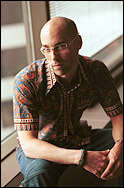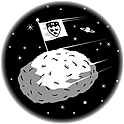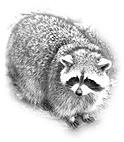Kaleidoscope
Steven McClenaghan: Playing with design
 PHOTO: Owen Egan
PHOTO: Owen Egan |
|
Well before Steven McClenaghan became the McGill News graphic designer in 1998, word of his talent had already reached the magazine's editor. Through a mutual acquaintance, Diana Grier Ayton recalls being prodded, "Take him! Take him! He's great."
Three years later, Grier Ayton is glad McClenaghan was hired. Not only has he developed a strong design partnership with the McGill News editorial team, he's helped the alumni magazine win awards.
The latest distinction came from the Canadian Council for the Advancement of Education (CCAE) this spring, which named the McGill News as Canada's best university magazine. The judges raved that the magazine in general, and McClenaghan's work in particular, showed a "strong contemporary design and animated graphic approach."
For McClenaghan, the CCAE nod came on the heels of another award from the University and College Designers Association (UCDA), which represents designers who promote higher education across North America. Selected from among more than 1,400 submissions, McClenaghan's work on an article about McGill's Evolution Education Research Centre grabbed a silver medal from the UCDA.
But don't go thinking the McGill News is McClenaghan's sole vocation. As the major client designer for McGill's Instructional Communications Centre, his projects encompass everything from posters to pamphlets, all tailored to keep the McGill name in the public eye.
Yet of all his duties, McClenaghan finds designing the McGill News one of his biggest challenges. The reason? Unlike typical magazines, which are usually narrowcast to niche markets, the McGill News caters to a wide spectrum of graduates -- twentysomethings to seventysomethings, small business owners to Fortune 500 CEOs, painters to physicians.
"What I come up with has to work for all of them," McClenaghan says.
He has achieved that goal by giving the magazine a clean and simple style, but one with playful flourishes. He reads racks of magazines every month to keep current -- naming Vice, Paper, Shift and Blue magazines as influences -- and incorporates tricks of the trade he spots and likes.
The positive response so far has encouraged him to try to alter the McGill News look a little in forthcoming issues. "There's still so much I want to do with the magazine," he says, adding he'd like to give the publication a slicker, artier look. "I'm doing it gradually."
Garry Graham, manager and art director of ICC's graphic design section and McClenaghan's supervisor, says his employee is constantly dazzling him with his fresh approach to the craft. "Steven always goes out of his way to give his designs a little something extra," he says.
A case in point is how McClenaghan scanned a wicker placemat -- taken from his own home -- as a backdrop for an upcoming McGill News feature. Considering the story is on Jan Wong, The Globe and Mail's catty "Lunch With" columnist, the placemat provided some appropriate visual panache.
For another McGill News story on campus trees, McClenaghan brought in a piece of bark to scan as a backdrop. "He's very inventive and artistic," says Graham. "Whatever project he takes on, he just runs with it, which delights me. That's what ICC likes to encourage."
McClenaghan, in turn, credits the input he gets from his ICC colleagues. During weekly meetings, for instance, "we critique each other's work to produce better layouts."
Grier Ayton says McClenaghan is filled with great ideas that help give each issue of the McGill News an edge. "He's very ingenious and meticulous," she says. "And I like that he always reads our stories so that his ideas start percolating before he even lays out a feature."
McClenaghan says his design inspirations come from a variety of sources, often from the visual stimulants on St. Laurent Blvd., where he lives. At 37, he also tries to keep his design fresh and youthful by remaining vibrant himself.
Consider it a mission accomplished. As he sits in ICC's 16th-floor offices, with his sleek shaved head, clear wrap-around Prada glasses, clingy bold-print shirt and $3 chunky used golden ring, McClenaghan looks like he just arrived from a fashion shoot for Spin.
He also keeps in touch with other artistic milieus. Indeed, he was one of 2,200 people who recently got naked downtown for American photographer Spencer Tunick. "I couldn't pass up taking part in a once-in-a-lifetime event like that," McClenaghan says of the experience.
But McClenaghan is most passionate about magazine design. Reflecting on his job, he says, "I feel like I'm getting paid to have fun."
 |
||||
|
"We don't know what goes on, whether even a brother or sister might be receiving a kickback. We have turned down donors when we suspect things are fishy, or that they might be getting money." |
||||
Look up. Way up
 ILLUSTRATION: Tzigane
ILLUSTRATION: Tzigane |
|
McGill isn't confined to the island of Montreal. McGill research stations exist in freezing cold climes (northern Quebec) and balmy locales (Barbados). Teaching programs exist in Panama and Japan. And now a little piece of McGill lies in the asteroid belt between Mars and Jupiter, orbiting the sun every three years or so.
Make that a big piece of McGill.
An asteroid discovered back in 1990 by astronomers David Levy and Henry Holt has officially been named after the University. The Montreal-born Levy, who describes the asteroid as "a small world with sunrises and sunsets," attended McGill as an undergraduate. Although he went on to finish his degree at Acadia University, Levy says "McGill has been as much a part of life as my own home."
Levy is one of the world's most famous comet-finders. He has discovered 21, eight of them using his own backyard telescopes. His most famous find, made with a pair of colleagues, was Shoemaker-Levy 9, the comet that collided with Jupiter in 1994.
Levy's father, Nathaniel, attended McGill, regaling his family with tales of his economics professor, Stephen Leacock. Levy has nephews and nieces who have gone to McGill since. While he was here himself, he worked on The McGill Daily, training he puts to use today as the science editor for Parade, a magazine with a circulation of 80 million. He is also a contributing editor at Sky and Telescope and a columnist for Skynews. He earned an Emmy for his contributions to a Discovery Channel documentary.
Why did it take over 10 years for McGill the asteroid to earn its moniker? Observations of the asteroid have to be collected for a full orbit before a name can be proposed.
 |
||||
|
"In view of the recent vote-counting fiasco in Florida, it would be more logical to invite the Americans to share our constitutional monarchy than to abolish it ourselves." |
||||
When nature drives you buggy
 |
|
Got a skunk under your deck? Bats in your attic? Aphids in your garden? Who you gonna call?
Macdonald Campus's Urban Nature Information Service might be your best bet.
Staffed by plant science student Frieda Beauregard and applied zoology student Marie-Anne Hudson, the service offers a summer hotline for gardeners and cottagers searching for tips on how to shoo away racoons or combat fungi.
The duo field about 50 calls per week. "For some questions, the answers are pretty cut and dried," says Hudson. More complicated queries send the students off on mini-research projects for which they often recruit the expertise of Macdonald professors such as bird expert David Bird or entomologist David Lewis. "We're both learning a lot," notes Hudson.
"If we can't answer the question right away, we're usually able to offer some information within a day," adds Beauregard.
Squirrels might look cute, but they earn the wrath of plenty of gardeners for unearthing tulips, says Hudson. The pesky varmints are among the most dogged of four-legged pests. Hudson suggests using Ro-Pel, a non-toxic animal repellent that "tastes really bad."
Are birds roosting in an unwelcome spot? Try making the area decidedly uncomfortable with spiky materials along the lines of porcupine quills. Think you've spotted an orphaned bird? Don't be too hasty -- the mother may be eyeing you from a tree, waiting for you to go away before checking on her little one, advises Hudson.
Work study grants and funding from several municipalities help support Hudson and Beauregard's work.
The pair welcome visits, especially if you have a plant or bug you need help identifying. "That can be difficult to do over the phone," says Beauregard.
The Urban Nature Information Service can be reached at 398-7882 (phone), 398-7897 (fax), wildlife@nrs.mcgill.ca or hic@macdonald.mcgill.ca. Offices are located at room R3-038 of the Raymond Building and the service is open from 9 am to noon and from 1 pm to 4 pm, Monday to Friday.

